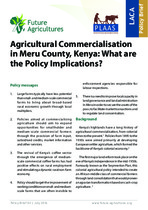| dc.contributor.author | Hakizimana, Cyriaque | |
| dc.date.accessioned | 2019-03-01T11:25:01Z | |
| dc.date.available | 2019-03-01T11:25:01Z | |
| dc.date.issued | 2016 | |
| dc.identifier.citation | Hakizimana, C. (2016). Agricultural commercialisation in Meru County, Kenya: What are the policy implications?. Policy Brief 84, Bellville: Institute for Poverty, Land and Agrarian Studies, University of the Western Cape | en_US |
| dc.identifier.uri | http://hdl.handle.net/10566/4319 | |
| dc.description.abstract | Kenya’s highlands have a long history of agricultural commercialisation, from colonial times to the present. Policies from 1895 to the 1930s were aimed primarily at developing European settler agriculture, which formed the backbone of Kenya’s colonial economy. The first major land reform took place on the eve of Kenya’s independence in the mid-1950s. Famously known as the Swynnerton Plan, this colonial agricultural policy intended to create an African middle class of commercial farmers through land consolidation that would pioneer an agrarian transformation based on cash-crop agriculture. | en_US |
| dc.language.iso | en | en_US |
| dc.publisher | Institute for Poverty, Land and Agrarian Studies, University of the Western Cape | en_US |
| dc.relation.ispartofseries | Policy Brief: Future Agricultures Consortium;84 | |
| dc.subject | Kenya | en_US |
| dc.subject | Meru County | en_US |
| dc.subject | Agricultural commercialisation | en_US |
| dc.subject | Land reform | en_US |
| dc.subject | Smallholder farms | en_US |
| dc.title | Agricultural commercialisation in Meru County, Kenya: What are the policy implications? | en_US |
| dc.type | Other | en_US |

